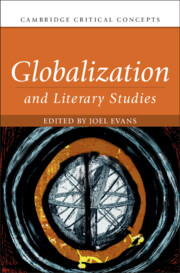Book contents
- Globalization and Literary Studies
- Cambridge Critical Concepts
- Globalization and Literary Studies
- Copyright page
- Contents
- Figures
- Tables
- Contributors
- Acknowledgements
- Introduction
- Part I Origins
- Part II Development
- Chapter 6 Joseph Conrad, the Global and the Sea
- Chapter 7 Mutual Equality
- Chapter 8 Edward Said
- Chapter 9 The New McWorld Order
- Chapter 10 Pharmakon, Difference and the Arche-Digital
- Chapter 11 Time–Space Compression
- Chapter 12 The Matter of Blackness in World Literature
- Chapter 13 World-Systems, Literature and Geoculture
- Chapter 14 World Author
- Part III Application
- References
- Index
Chapter 11 - Time–Space Compression
The Long View
from Part II - Development
Published online by Cambridge University Press: 01 April 2022
- Globalization and Literary Studies
- Cambridge Critical Concepts
- Globalization and Literary Studies
- Copyright page
- Contents
- Figures
- Tables
- Contributors
- Acknowledgements
- Introduction
- Part I Origins
- Part II Development
- Chapter 6 Joseph Conrad, the Global and the Sea
- Chapter 7 Mutual Equality
- Chapter 8 Edward Said
- Chapter 9 The New McWorld Order
- Chapter 10 Pharmakon, Difference and the Arche-Digital
- Chapter 11 Time–Space Compression
- Chapter 12 The Matter of Blackness in World Literature
- Chapter 13 World-Systems, Literature and Geoculture
- Chapter 14 World Author
- Part III Application
- References
- Index
Summary
Time-Space Compression is one of the most influential concepts in globalization theory. Focused by David Harvey in 1990 on spatial shrinkage and temporal simultaneity, it offered an account of the metaphorical contraction of the globe in relation to travel speed. This chapter explores its legacy, and argues that, since 1990, the economic and cultural meanings of time-space compression have shifted towards a conception of uncertainty: it aims to show that the vocabulary has changed in order to break with a kind of complicity that social theory has identified between capitalist expansion and social-scientific commentary. Time-space compression has turned away from the emphasis on global simultaneity, towards questions about the knowability of the future. Bernard Stiegler is one theorist who has developed a new account of epochal temporality for the digital age which has transformed canonical notions of time-space compression by giving them a future orientation. Stiegler’s work also offers us ways of thinking about narrative as a form of belatedness, and about the way that the interval between events and their reception might be eliminated by the inner forms of narrative and the novel.
Keywords
- Type
- Chapter
- Information
- Globalization and Literary Studies , pp. 178 - 194Publisher: Cambridge University PressPrint publication year: 2022

